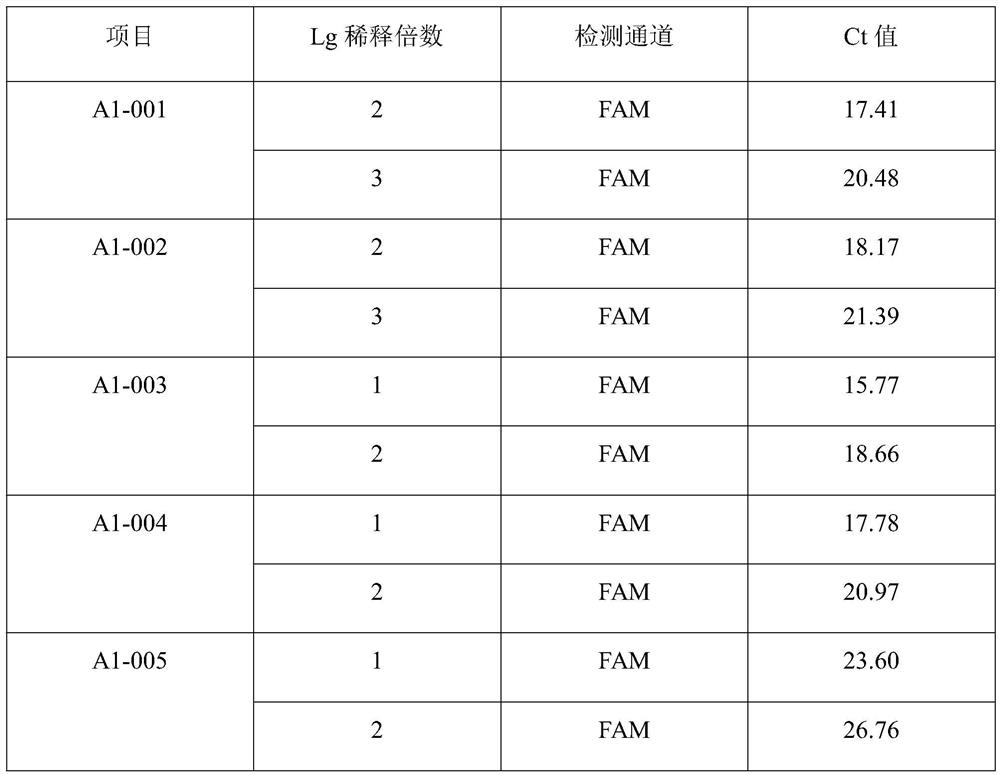Method for detecting influenza virus titer through fluorescent quantitative PCR
An influenza virus, fluorescence quantification technology, applied in microorganism-based methods, microbial determination/inspection, biochemical equipment and methods, etc., can solve the problems of long detection time, poor practicability, poor repeatability of results, etc. , High practicability and high repeatability
- Summary
- Abstract
- Description
- Claims
- Application Information
AI Technical Summary
Problems solved by technology
Method used
Image
Examples
Embodiment 1
[0037] A method for detecting influenza virus titer by fluorescent quantitative PCR, comprising the following steps:
[0038] (1) Extract the RNA of the sample to be tested:
[0039] ①Take the virus sample, add the lysate, mix well and place it at room temperature for 5 minutes, then add the buffer solution to the lysed sample solution, mix well and transfer the mixture to an affinity column with a liquid connection tube, 13000r / min Centrifuge for 30 seconds and discard the filtrate;
[0040] ② Add 500 μl of washing solution to the affinity column, centrifuge at 13000r / min for 30 seconds, and discard the filtrate;
[0041] ③Repeat step ②;
[0042] ④Put the affinity column into the liquid tube, centrifuge at 13000r / min for 2 minutes, discard the liquid tube and filtrate; then put the affinity column into a new centrifuge tube, and absorb the membrane to the bottom of the affinity column. Add 50 μl of eluent to the center, place at room temperature for 2 minutes, and centrifu...
Embodiment 2
[0057] A method for detecting influenza virus titer by fluorescent quantitative PCR, comprising the following steps:
[0058] (1) Extract the RNA of the sample to be tested:
[0059] ①Take the virus sample, add the lysate, mix well and place it at room temperature for 5 minutes, then add buffer solution to the lysed sample solution, mix well, transfer the mixture to an affinity column with a liquid tube, 13000r / min Centrifuge for 30 seconds and discard the filtrate;
[0060] ② Add 500 μl of washing solution to the affinity column, centrifuge at 13000r / min for 30 seconds, and discard the filtrate;
[0061] ③Repeat step ②;
[0062] ④ Put the affinity column into the liquid tube, centrifuge at 13000r / min for 2 minutes, discard the liquid tube and the filtrate; then put the affinity column into a new centrifuge tube, and absorb the membrane to the bottom of the affinity column. Add 50 μl of eluent to the center, place at room temperature for 2 minutes, and centrifuge at 13,000 ...
Embodiment 3
[0076] A method for detecting influenza virus titer by fluorescent quantitative PCR, comprising the following steps:
[0077] (1) Extract the RNA of the sample to be tested:
[0078] ①Take the virus sample, add the lysate, mix well and place it at room temperature for 5 minutes, then add buffer solution to the lysed sample solution, mix well, transfer the mixture to an affinity column with a liquid tube, 13000r / min Centrifuge for 30 seconds and discard the filtrate;
[0079] ② Add 500 μl of washing solution to the affinity column, centrifuge at 13000r / min for 30 seconds, and discard the filtrate;
[0080] ③Repeat step ②;
[0081] ④ Put the affinity column into the liquid tube, centrifuge at 13000r / min for 2 minutes, discard the liquid tube and the filtrate; then put the affinity column into a new centrifuge tube, and absorb the membrane to the bottom of the affinity column. Add 50 μl of eluent to the center, place at room temperature for 2 minutes, and centrifuge at 13,000 ...
PUM
 Login to View More
Login to View More Abstract
Description
Claims
Application Information
 Login to View More
Login to View More - R&D
- Intellectual Property
- Life Sciences
- Materials
- Tech Scout
- Unparalleled Data Quality
- Higher Quality Content
- 60% Fewer Hallucinations
Browse by: Latest US Patents, China's latest patents, Technical Efficacy Thesaurus, Application Domain, Technology Topic, Popular Technical Reports.
© 2025 PatSnap. All rights reserved.Legal|Privacy policy|Modern Slavery Act Transparency Statement|Sitemap|About US| Contact US: help@patsnap.com



